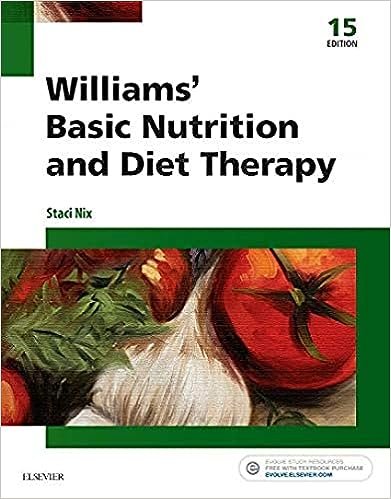Test Bank for Lutzs Nutrition and Diet Therapy 7th Edition Mazur Litch
Chapter 3. Fats
MULTIPLE CHOICE
1. The functions of fat in the body include
a. enzyme production, insulation of long bones, and bone structure.
b. formation of bone structure and energy for daily activities.
c. flavoring low fat foods, supplying fatty acids, and lubrication for vital organs.
d. insulation of vital organs, temperature regulation, and cell membrane structure.
ANS: D
In the body, fat around vital organs and under the skin provides insulation and helps regulate
body temperature; fat is also a component of cell membrane structure.
DIF: Cognitive Level: Knowledge REF: 36 TOP: Nursing Process: Planning
MSC: NCLEX: Physiological Integrity: Physiological Adaptation
2. The number of kilocalories from fat in a meal that contains 35 g fat is
a. 35.
b. 140.
c. 315.
d. 350.
ANS: C
Fat contains 9 kcal/g, so 35 g 9 kcal/g = 315 kcal.
DIF: Cognitive Level: Application REF: 36
TOP: Nursing Process: Assessment
MSC: NCLEX: Physiological Integrity: Physiological Adaptation
3. The recommended total calories provided by fat in an 1800 calorie diet would be
a. 180-270 calories.
b. 360-630 calories.
c. 540-630 calories.
d. 540-720 calories.
ANS: B
It is recommended that no more than 20% to 35% of total calories come from fat. In an 1800
calorie diet: 1800 x .20 = 360 calories. 1800 x .35 = 630 calories.
DIF: Cognitive Level: Application REF: 42-43
TOP: Nursing Process: Implementation
MSC: NCLEX: Physiological Integrity: Physiological Adaptation
4. An element not found in triglycerides is
a. carbon.
b. hydrogen.
c. nitrogen.
d. oxygen.
ANS: C
Carbon, hydrogen, and oxygen make up fat, whereas nitrogen is found as part of the protein
molecule.
DIF: Cognitive Level: Knowledge REF: 31 TOP: Nursing Process: Planning
MSC: NCLEX: Physiological Integrity: Physiological Adaptation
5. Triglycerides are composed of
a. glycerol and amino acids.
b. transfatty acids.
c. hydrogenated fatty acids.
d. glycerol and fatty acids.
ANS: D
A triglyceride is composed of three fatty acids attached to a glycerol base.
DIF: Cognitive Level: Knowledge REF: 31 TOP: Nursing Process: Planning
MSC: NCLEX: Physiological Integrity: Physiological Adaptation
6. The chemical feature that distinguishes a saturated fatty acid from an unsaturated fatty acid is
the
a. amount of water it contains.
b. amount of cholesterol it contains.
c. source.
d. amount of hydrogen it contains.
ANS: D
Fatty acids are saturated or unsaturated depending on whether they are filled with hydrogen. A
fatty acid that is not completely filled with all the hydrogen it can hold is unsaturated; the
structure of a saturated fatty acid is completely filled with all the hydrogen bonds it can hold.
DIF: Cognitive Level: Knowledge REF: 31-32 TOP: Nursing Process: Planning
MSC: NCLEX: Physiological Integrity: Physiological Adaptation
7. An example of a food that contains a high level of saturated fatty acids is
a. beef steak.
b. olive oil.
c. green tomatoes.
d. whole-grain bread.
ANS: A
Saturated fats are commonly found in animal products. Unsaturated and monounsaturated fats
are mostly derived from plant sources. However, tropical oils such as coconut and palm oils as
well as hydrogenated oils are saturated.
DIF: Cognitive Level: Application REF: 32
TOP: Nursing Process: Implementation
MSC: NCLEX: Physiological Integrity: Physiological Adaptation
8. Of the following fats, the one that is least saturated is
a. safflower oil.
b. corn.
c. cottonseed.
d. soybean.
ANS: A
Unsaturated fats listed in order of degree of unsaturation are safflower, corn, cottonseed, and
soybean.
DIF: Cognitive Level: Application REF: 33 TOP: Nursing Process: Planning
MSC: NCLEX: Physiological Integrity: Physiological Adaptation
9. Most fatty acids in plant foods are
a. monounsaturated.
b. polyunsaturated.
c. unsaturated.
d. saturated.
ANS: C
Plant foods are mostly composed of unsaturated fats. However, tropical oils such as palm, palm
kernel, and coconut as well as hydrogenated oils are composed of saturated fats.
DIF: Cognitive Level: Comprehension REF: 33 TOP: Nursing Process: Planning
MSC: NCLEX: Physiological Integrity: Physiological Adaptation
10. A patient is concerned with her weight. Her energy intake is calculated to be 1600 calories.
Intake records reveal that her fat intake for the past month has been 120 calories or less per day.
The appropriate intervention would be to
a. assess for essential fatty acid deficiency.
b. continue to monitor for changes.
c. continue current meal plan.
d. draw lab work immediately.
ANS: A
An essential fatty acid is one that is essential for the body; its absence will create a specific
deficiency. The body cannot manufacture essential fatty acids and must obtain them from the
diet.
DIF: Cognitive Level: Analysis REF: 34
TOP: Nursing Process: Implementation
MSC: NCLEX: Physiological Integrity: Physiological Adaptation, Health Promotion and
Maintenance
11. The body needs linoleic acid for
a. digestion of food.
b. protein metabolism.
c. fluid balance.
d. blood clotting.
ANS: D
The body needs linoleic acid for functions related to tissue strength, cholesterol metabolism,
muscle tone, blood clotting, and heart action.
DIF: Cognitive Level: Knowledge REF: 34-35 TOP: Nursing Process: Planning
MSC: NCLEX: Physiological Integrity: Physiological Adaptation
12. The best food choice to provide linolenic acid is
a. strawberries.
b. canola oil.
c. raisin toast.
d. lard.
ANS: B
Linolenic acid is primarily found in soybean, canola, and flaxseed oil.
DIF: Cognitive Level: Application REF: 34
TOP: Nursing Process: Implementation
MSC: NCLEX: Physiological Integrity: Physiological Adaptation





Reviews
There are no reviews yet.